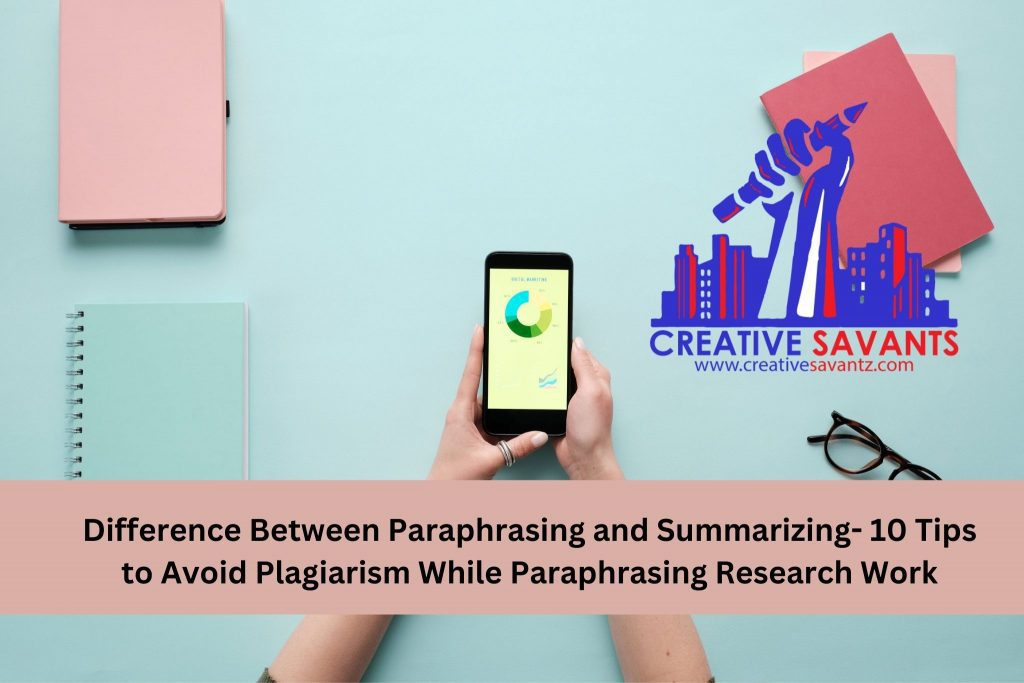Rewriting a piece of content usually involves paraphrasing and summarizing. Whether you are a student or a professional writer, it is important to understand the difference between these two terminologies. This article will discuss the key differences between paraphrasing and summarizing and how to avoid plagiarism while paraphrasing research work.

What is Summarizing?
It is called summarizing when you restate an article into a shorter form so that the reader can understand the article concisely. Whether it is a few paragraphs or sentences, it must contain the article’s main points so your readers understand what was included in the write-up.
Read More: A Simple Guide to APA Referencing
When is it Useful to Summarize?
Summarizing can be beneficial when:
- You want to give a brief introduction to the article.
- You want to communicate the main points of a long and complex article so that it is easy for everyone else to understand.
- You want to highlight important areas of an article or even a presentation.
- You want to save a short version of the article for the future.
- You want to reduce the reading time for an article.
Read more: The Ultimate Guide on How to Getting Study Assistance From Friends
What is the Advantage of Summarizing?
Summarizing is helpful in many ways, not only for the readers but for writers, too. Comprehensively writing a piece of article helps to identify the main key points. The key ideas get clearly defined, so nobody gets lost in the context. Summaries only provide essential information without the jargon. It also helps identify any gaps that may exist in the research.
What is Paraphrasing?
Paraphrasing and summarizing often go hand in hand, but there is a difference between these two terminologies. Unlike summarization, paraphrasing is when you have to use your creative mind to write an article from another. But when you paraphrase, you try to keep the original meaning intact so that the main idea of the authentic article remains the same. If you need help to grasp the concept of paraphrasing, then Creative Savants is here to help you out every step of the way.
Read More: Do’s and Don’ts of Paraphrasing: Ten Mistakes you must Avoid at all Cost- September 2024
When is it useful to paraphrase?
Paraphrasing can be beneficial when:
- You have to give a reference from a source
- You have to write a challenging article in an easy-to-understand manner
- You have to add some spark to an article
- You have to give a different angle to the topic
- You want to increase the quality of the content

What is the Advantage of Paraphrasing?
Both paraphrasing and summarizing have quite a few benefits. It helps to get a more straightforward and better understanding of the topic. It gives the readers a new perspective on the topic. Moreover, it helps to develop the writing style, but most of all, it helps avoid plagiarism.
What is the Main Difference between Paraphrasing and Summarizing
People often see several similarities between summarizing and paraphrasing. Yet, both of these terminologies are completely different from one another. Let us discuss a few points about how both of these terms are opposite to each other.
Meaning
Summarizing is condensing an article, whereas paraphrasing is rewriting an article. In paraphrasing, we distort the original text without altering its meaning. On the other hand, summarizing is when the key concepts of an article are compressed understandably.
Additional Details
When paraphrasing, you can add your thoughts, examples, views, and perspectives. You can even conclude it as you want.
When summarizing, you have to mention the exact details of the article without changing the results or expressing your opinion.
Learn more: Pearson Mystatlab Answers And Solutions For Online Statistics Students From Experts
Length
When paraphrasing, there is no limit to the length of the article. It can even be longer or shorter than the original piece.
In the case of summaries, the summarized version is very much shorter than the original content.
Writing Time
Summaries are written quickly in comparison to paraphrasing, as it takes longer because you will have to concentrate on the important details of the article.

Paraphrasing and Summarizing Examples
Original
Today, the World Health Organization released two new publications, “Freedom from Tobacco and Nicotine: a Guide for Schools” and “Nicotine- and Tobacco-free School Toolkit,” to help protect children’s health just in time for back-to-school season in many countries.
The tobacco industry relentlessly targets young people with tobacco and nicotine products resulting in e-cigarette use increasing and 9 out of 10 smokers starting before the age of 18. Products have also been made more affordable for young people by selling single-use cigarettes and e-cigarettes, which typically lack health warnings.
Paraphrasing
WHO has recently released two publications regarding the freedom to use nicotine and tobacco in schools. A nicotine and tobacco-free school toolkit will help protect several children’s health in school.
Young people are the most common target for many tobacco industries. According to a survey, 9 out of 10 smokers started smoking at 18. One reason for its popularity is its affordability, and that too without health warnings.
Read More: Understanding Paraphrasing and Paraphrasing Exercises
Summarizing
WHO released two publications on tobacco and nicotine use in schools and introduced a free anti-nicotine school toolkit. Young people are a popular target for the tobacco industry.
What is Plagiarism?
Plagiarism is when a writer copies the original work of another writer and pretends to own it. One type of plagiarism is called direct plagiarism. In this type, one writer copies, the other writer’s work word to word. The second type is incorrect paraphrasing, where the writer uses their own words to change the original text. Then comes mosaic plagiarism, when the writer copies the entire content but changes the outline.
Is your content being rejected due to plagiarism? Here at Creative Savants, we have professional writers who can remove plagiarism from your articles just for you.
Read More: Chegg Plagiarism Checker Review (Completed)

Eventually, the result of any plagiarism is stealing somebody else’s work. However, there are many instances when writers need to know more about plagiarism. It may be because they have difficulty understanding the difference between plagiarism and paraphrasing. Here are a few tips on how you can avoid plagiarism when paraphrasing;
Plan and Start Early
One of the best ways to avoid plagiarism is to plan and start early to write an article. When someone writes quickly, they can easily miss out on copy time. When you have sufficient time to research, you will pay attention to what you write effectively, especially when paraphrasing and summarizing. Writing under pressure usually means that you will end up copying other’s stuff.
Quote Citations
You may be giving references and citations, but you must do it properly to avoid plagiarizing your content. Quoting citations is also essential when you are paraphrasing and summarizing an article. Ensure you set standards for your article and cite your sources accurately.
Read More: How to quote MLA citations
Plagiarism Checkers
Plenty of plagiarism checkers available online can do the difficult work for you. Once you have paraphrased an article, run it through the checker to see if there is any copied content.
Do you have access to Turnitin Plagiarism Checker? Visit the Creative Savants website and get your hands on the latest version of Turnitin plagiarism checker.
Read More: 5 Tips to Avoid Plagiarism
Proofreading
Proofreading means going through your article or reviewing it to see if there is any plagiarism. You can rewrite your article in the best way possible, but there are chances that you must have left out a point. Always proofread your articles before final submission.
Read More: What is Proofreading?
Quote Directly
When copying quotes or other people’s words, write them directly without paraphrasing and mention the writer’s name. Such practice is critical when paraphrasing, quoting, and summarizing any content. It will save you a lot of time, and you will not have to worry about plagiarism. A writer who quotes the original author will never be accused of plagiarism because they get their due credit.
Understanding the Original Article
Make sure that you thoroughly understand the original article. That will make it easier for you to paraphrase any article you want. Make sure that you pay special attention to the concepts and the main headings.

Use your Style of Writing
Every writer has his or her own method of writing. For instance, there are certain words that they use more commonly. The main purpose of paraphrasing is that the plagiarism and paraphrasing tools won’t detect you. To paraphrase your article correctly, identify your writing style and use it to paraphrase it.
Read More: Download Free Turnitin Plagiarism Checker Report 2024
Utilize Synonyms
Paraphrasing and summarizing both require the use of synonyms. Synonyms are words that have the same meaning but sound differently, and they are a great way to reduce plagiarism when paraphrasing. When using synonyms, make sure that you do not change the context. The next time you see the word help, you can write the word assist. The internet is full of synonyms that you can easily use.
Use a Combination of Sources
When paraphrasing, there is a high chance that you take an idea from a single source. Doing so increases your chance of getting caught by plagiarism checkers. Select a variety of sources and take ideas from them. It will help increase your scope of research, and you will not copy off from just one article.
Alter the Sentence Structure
The English language has several sentence structures and formats for you to use. These will help you go undetected by any plagiarism tool checker. For instance, if the source article is written in the first verb form, you can write in the second form instead. Try changing the passive voice into the active voice. Such practices will not change the meaning of the context.
Conclusion
Understanding the difference between plagiarism, paraphrasing, and summarizing is essential for students, lecturers, and professional writers. Summarizing involves putting the entire context of the article in a nutshell. Paraphrasing, however, requires content to be written in your own words while maintaining the original meaning behind the article.
Writers usually paraphrase an article to avoid plagiarism. Plagiarism is copying the work of another artist or even a writer and calling it your own. Follow the tips from this article if you want to stop plagiarizing your content after you are done paraphrasing and summarizing your content. If you are still finding it difficult, contact the professional experts at Creative Savants, who will help you paraphrase your article and that too, plagiarism-free.

